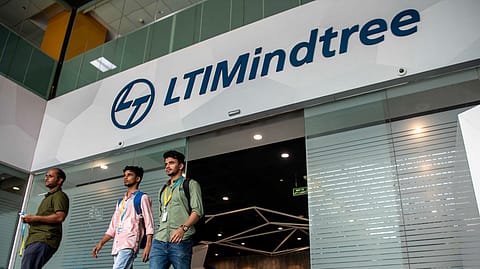Can LTIMindtree realise its ambitious $10-billion dream by FY32?
LTIMindtree’s bold ambition hinges on double-digit growth over the next 8 years, adding atleast $800 million in incremental revenue each year.

At the analyst meeting held at LTIMindtree's delivery centre in Mahape, Navi Mumbai, the new campus inaugurated last year, the company detailed its AI-led growth plan for the coming years. It has also set out an ambitious target of becoming a $10-billion revenue firm from the current $4.3 bn (FY24) by FY32 at a profit margin of 17-18%.
This growth, as LTIM sees it, will be based on three vectors. One, building a strong foundation by scaling particularly its BFSI and Tech verticals with deeper penetration into the Fortune 500 companies' client portfolio and deeper partnerships with hyperscalers and core platforms. Currently, the company has over 100 of the Fortune 500 list as its clients. Two, a strategic pivot towards artificial intelligence where the company plans to infuse AI into every service and solution that the company offers, and three, growing its BFSI, Technology, Media, Comms vertical 2X and Manufacturing, Resources, Healthcare, Lifesciences and Consumer Business 3X coupled with strategic acquisitions.
Further, the company also has set out an aggressive profitability target whereby it intends to take the margins to 17-18% from the current 15.5% (Q2FY25). For margin improvement, LTIM has its ongoing ‘Project Northstar’ exercise which envisages working around its pyramid cost, use of AI and automation, maximizing revenue per employee as well as prudence in spending on overheads.
Analysts from various research firms and brokerages who attended that meeting have had a mixed take on this plan. For instance, Nomura analysts Abhishek Bhandari and Krish Beriwal in their note say the upside risks are strong large-size deal wins and higher-than-expected margin expansion. Analysts at Emkay Global maintain that with discretionary spending yet to return and the US election uncertainty over, the coming months should provide better visibility for FY26 as clients will start finalizing their budgets.
In contrast, Motilal Oswal in a note seems to be more bullish. “We believe LTIM's strengths in data engineering and ERP modernization position it well to capture pre-GenAI investment opportunities. While margin expansion remains a key risk to our thesis due to unrealized merger synergies, we expect gradual improvement as demand strengthens,” the note said. Further, with BFSI clients increasing spending on transformation projects, the brokerage house sees the company benefitting despite its margin challenges.
However, if one takes a pragmatic look at where the company stands today, reaching the $10 billion mark seems a Herculean task. If one takes into consideration this fiscal year (FY25), the company will have to grow at a CAGR of over 11% in the next eight years. L&T acquired Mindtree in 2019, and the merger of erstwhile Larsen & Toubro Infotech Limited (LTI) and erstwhile Mindtree Limited (Mindtree) was completed in November 2022. At the end of March 22, LTI had revenue of around $2.1 billion and Mindtree at about $1.4 billion, making a combined revenue of $3.5 billion. Since the merger, at the end of FY23 LTIM’s revenue was $ 4.1 billion and the company ended FY24 at $4.3 billion, indicating a CAGR of 10.7%. This, in a volatile environment and with only a few companies in the sector willing to provide annual guidance, has many variables that could throw a spanner in its plans.
The company, as part of its growth strategy, has plans to go deeper into its top 100 accounts, increasing its cross-sell and upsell chasing large deals and adding new logos. According to the company, its top 100 accounts grew by 10% YoY in Q2 and saw a 15% increase in cross-selling in these accounts.
However, the company already faces a huge client concentration risk. According to data, the company's top 20 clients make nearly up for 46% of the revenue (see chart), compared to other companies such as Infosys where the top 25 clients make up 34.7% of the revenues, or HCL Tech where the top 20 clients bring 30.8 % of the revenues. The ability to add newer, bigger clients bringing deals at exceptional margins will be key if the company must grow both its revenues as well as margins to reach the goal. While an aggressive push on AI seems to be a silver lining, given the rate of industry adoption or the conversation around GenAI, the need for AI adoption is more of an inevitable action. However, while all IT service companies have a bullish outlook and lay out the number of AI/Gen AI projects in the works, one is yet to see any quantification in terms of revenue.
Also, what could be a likely catalyst in this period would be a change in leadership. Though media reports say AM Naik has indicated that the current CEO and Managing Director Debashis Chatterjee will continue through 2025, if one takes into consideration the eventuality of a change in the next 7 years, this will very well turn out to be a headwind. In most cases, as seen at IT services companies, the directionality, pace of growth and stability would all be impacted more so, if there is an outsider in the corner room. For now, this ambition hinges on many ifs and buts, while only a clear road map laid out by the company of how it plans to achieve this $ 10 billion target could instil real confidence in investors.